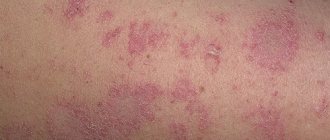The symptoms of these diseases have both similar features and completely different ones. Allergies are caused by the human body's reaction to an irritating substance - an allergen, and scabies occurs when a scabies mite appears on the skin. The article will tell you how to distinguish them.
Distinctive features
An allergic rash is absolutely not contagious, unlike scabies. The second disease is caused by a skin parasite - the scabies mite. The main source of infection is tick-infected patients, as well as their belongings (dishes, clothes, bedding, toys). In most cases, infection occurs at night, when the scabies mite is most active.
Of 100% of cases, the diagnosis of scabies is made to young people under 30 years of age, one in five of whom are children. Foci of infection are often found in schools, kindergartens and hospitals.
The common symptom of both diseases is a rash and itchy skin. But thanks to some features of the symptoms, you can understand how to distinguish scabies from allergies. What to pay attention to:
- Period of itching. The difference between allergic rashes is that the skin itches around the clock, regardless of the time of day. The itching of scabies is caused by the life cycle of the scabies mite. After sunset, the parasite wakes up to reproduce, for which it begins to dig tunnels, which causes severe itching in the evening and at night.
- The nature of the rash. The areas of the rash also differ. It is much easier to recognize an allergic rash, since it abundantly covers areas of the body on the arms, face, legs, torso, and abdomen. The tick loves to settle in the most delicate areas of the human body; the favorite localization of the parasite is:
spaces between the phalanges and lateral surfaces of the fingers;- genitals in men;
- inner thighs;
- lateral surfaces of the feet. The mite very rarely settles on the scalp and facial skin. In these places, infection occurs more often in infants.
place of bend of the wrist joints;
You can independently check which disease has affected a person, allergies or scabies, in simple ways:

Any antihistamine helps with allergic rashes. After taking allergy medications, the patient feels better, the itching decreases, and overall health improves. Antihistamines do not work on scabies mites.- Also a feature of allergic dermatitis is the accompanying symptoms of intoxication:
- sneezing;
- lacrimation;
- general weakness. With scabies, the general condition of the patient remains normal. Severe itching of the skin is caused by an allergic reaction to the existence of the mite and its metabolic products. Very often, after scratching the passages created by the parasite, a secondary infection occurs, and pustular formations appear at the site of the rash.
runny nose;
Content
Parasitic skin diseases
| The most common parasitic skin diseases are pediculosis, demodicosis and scabies. | Parasitic skin diseases remain a fairly pressing problem due to their prevalence at present. The most common parasitic skin diseases are those caused by mites. |
Parasites are organisms that feed on individuals of another species and are permanently or temporarily located inside the organism or on its surface [1]. The organism in which the parasite permanently or temporarily lives and through which it feeds is the host.
Not only these organisms are called parasites, but also those that cause harm to the host. Depending on where the parasites live in the host’s body, they are divided into endo- and ectoparasites. Parasites can be permanent or temporary. Permanent parasites are living organisms that live on the body or in the body of the host throughout their lives at all stages of development and cannot exist otherwise. Temporary parasites are on the host only to eat and mainly exist outside the host. There are also pseudoparasites, or false parasites - free-living forms that accidentally enter the body and temporarily reside in it, feeding at its expense.
A distinctive feature of parasites is their maximum adaptability to the host organism and special conditions of existence [1]. In the process of evolutionary changes, they developed many adaptations to specific conditions and a special way of life.
|
| Physiological |
DevicesType of adaptation
| Morphological |
Definitive, or final, is an organism in which parasites go through the entire life cycle of development from an egg, a nymph, to a sexually mature individual and reproduce sexually. For their host, parasites are foreign organisms, pathogenic due to the secretion and excretion of various substances. If there is one permanent host and goes through all phases of development in it, pathogenetic and immunological processes can be of varying intensity, as well as the influence of parasites on the host’s body. Minor effects on the host’s body are quite rare; most often, pronounced lesions are observed with the development of diseases and complications [1].
Defense reactions of the host body:
In the minds of the average person, homeless people and dirty people suffer from scabies. In reality, the scabies mite (Sarcoptes scabiei) does not suffer from prejudice - it is ready to live on anyone: be it a beggar or a top model. Of course, personal transport reduces the risk of disease, and the further you are from the city floor, the lower the risk of catching it. However, anyone can become infected with scabies. And neglect of hygiene has nothing to do with it. Regular use of “scented soap and fluffy towels,” as well as minimal disgust in using other people’s things, reduce the likelihood of infection. Reduce, but do not eliminate!
Therefore, you should not blame the sick person for some kind of incorrect behavior and consider scabies a shameful disease. Otherwise, following the same logic, it is a shame to have chickenpox and flu.
Myth 2. There is no way I could have gotten scabies.
The main symptom of scabies is unbearable itching of the skin, which tends to intensify in the evening and at night. The peak of itching occurs at night, during sleep of the infected person, due to the fact that at this time the mites come to the surface of the skin for the mating process, after which the females actively begin to look for a place under the skin to lay eggs.
All signs of scabies are divided into primary and secondary. Secondary symptoms for each infected person may be individual in nature, as they depend on the body’s allergic reaction and the strength of the immune system. The signs of scabies are also influenced by a person's skin type - oily or dry, as well as the rate of sweating. If a person becomes infected with scabies for the second time, the signs of the disease then have a less pronounced symptomatic picture.
A person simply cannot immediately recognize the disease, since at first it seems that there is a simple desire to scratch. This natural desire is difficult to distinguish from scabies.
After infection, the incubation period, that is, the time the first symptoms appear after infection with a scabies mite, can last from two hours to two weeks (this also depends on the person’s immune system). After an adult female reaches the surface of the skin, she begins to build passages under the skin after a few hours, after which reproduction occurs. If a young individual gets on the skin, it begins to parasitize only after it has fully matured. It is in this case that the first symptoms may appear two weeks after infection.
In order to identify a disease that was caused by a scabies mite, it may take up to seven days, and sometimes a longer period is required.
Examination methods
In addition to visually identifying characteristic external differences between the two diseases, there are laboratory diagnostic methods. An experienced dermatologist will know how to distinguish scabies from dermatitis, and will therefore recommend a series of procedures.
Scabies is most difficult to diagnose in children. If the infection occurs in a child under 6 months, then typical differences from allergies may not be detected.
The disease is more reminiscent of urticaria or weeping eczema. Ticks very rarely infect the lateral phalanges of the fingers and the spaces between the fingers in children under 3 years of age, but they often destroy the nail plates.
Identifying scabies mites
There are several methods for diagnosing scabies, which require high-quality equipment. After an external examination of the skin, the doctor will need to identify the scabies. The tunnels made by the parasite are not always clearly visible, so they can be determined in the laboratory:

Processing with dyes. The intended area of leather is stained with iodine, aniline dye or ink. When stained, the substance penetrates the scabies tracts, after which they are visualized. Residues of dyes are washed off without detergent or mechanical impact.- Videodermatoscope examination. Diagnosis of scabies is much simpler when the affected skin area is analyzed under a special device that magnifies the image of the epidermis by 400-600 times.
- Skin analysis under a violet lamp. The skin is pre-treated with medicinal solutions, then illuminated under a blue lamp. Scabies have a greenish-yellow tint.
- Scraping for accurate diagnosis. The technique makes it possible to identify not only the adult individual, but also the larvae, eggs, and waste products of the parasite. The place where the tick is supposed to live is treated with a 40% lactic acid solution.
This substance loosens the upper layers of the skin, which makes it possible to collect material for research. Typically, skin sampling occurs on the wrist, hands, or elbows. After 5 minutes, the laboratory assistant scrapes the skin cells until small droplets of blood appear. You need to scrape off the affected tissue at the border with healthy skin.
Allergy tests
Diagnosis of allergies has a completely different direction. First of all, the patient undergoes skin tests with the introduction of various allergens. Allergen tests are different:
- Scarification.
- Prick-test.
- Nasal provocative tests.
- Inhalation challenge test.
In addition to specific tests, determination of allergens is possible using a blood test (ELISA or RAST test).
Differential diagnosis of allergies requires more time. As a rule, due to the instability of the immune system, it is difficult to determine the cause of a child's allergies.
When diagnosing an allergy, the doctor must ask the patient whether a new product was eaten, whether the powder or detergent was changed, whether there was contact with pets, etc. etc. Sometimes it takes more than one month to find the pathogen.
Differential diagnosis of allergies and scabies should distinguish these diseases from others, where itching and rash are also the main symptoms:
- pyoderma;
- eczema;
- diabetes;
- bile stagnation;
- Hodgkin's disease;
- flea or mosquito bites;
- pubic lice (if the skin in the groin area is itchy).
Diagnosing scabies does not require much time; an experienced dermatologist can quickly determine the pathology. It is quite difficult to distinguish scabies from allergies yourself, so without consulting a specialist, treatment may be prescribed incorrectly. There is no need to risk your health, neither yours nor your child’s: any itchy skin rashes should be shown to a dermatologist and only then treated.
about the author
Editor of the project DoloyPsoriaz.ru
Useful article?
Today, many people are diagnosed with allergic reactions or scabies mites. How to distinguish scabies from allergies? The main difference between a parasitic infection is the high risk of infecting others. For timely and correct diagnosis, you should consult a doctor at the first appearance of symptoms. The doctor, after diagnostic procedures, will prescribe therapeutic measures for a specific case.
Disease carriers
Pseudoscabies is caused by scabies mites that parasitize animals. These are small mites Sarcoptes scabiei canis that live on dogs, cats, sheep, horses, goats, chickens and pigeons.
Bird mite dermatitis and snake mite dermatitis are also known. The so-called grain scabies is caused by the bellied mite Pyemotes ventricosus and the straw mite Pyemotes tritici. These mites parasitize the larvae of grain pests.
The disease can also occur due to shoe mites Tyrophagus longior and Acarus siro living in shoes. In urban environments, ticks reproduce all year round, but the peak of the disease often occurs in the spring .
Are the symptoms of scabies and allergies similar?
Allergy (dermatitis) is a response from the immune system to various types of irritants, and scabies is a parasitic disease that is provoked by scabies mites. Certain symptoms of these diseases are similar, namely the appearance of spots and itching on the skin. It is worth knowing that allergies and scabies require different therapeutic measures. You should not self-medicate, and at the first sign of symptoms you should consult a doctor.
Return to contents
External symptoms of allergies and scabies
The main symptoms of allergies and scabies in humans include inflammatory manifestations on the skin, which are accompanied by itching or burning. The appearance of the rash may be the same or similar, but the itching is significantly different. This is explained by the nocturnal lifestyle of the parasitic creature, as a result of which itching with scabies appears at night. Allergic burning does not depend on the time of day or night; as a rule, it is constant.
The distinctive external manifestation of an itch rash includes the presence of burrows that look like light scratches raised above the skin in a straight or zigzag shape. The passage ends in a transparent bubble with a white area inside (mite) and is clearly visible on dark (dark or tanned) skin. In young children (infants), the rash caused by scabies is localized in the area of the feet, face and scalp. Scabies rash in adults is primarily found in the area:
- hands (interdigital bends and lateral part of the finger);
- joint bends;
- breasts (often on the nipples);
- buttocks;
- genitals;
- inner thigh;
- belly.
Return to contents
Differences between allergies and scabies
Distinctive signs of scabies allergies in humans include:
- Allergic rashes are removed with the help of antihistamines; they have no effect on scabies.
- Symptoms of allergies (dermatitis) are often accompanied by a weak general condition, malaise, lacrimation, and runny nose. Such symptoms are not typical for parasitic infection.
- If someone in the family is infected with a scabies mite, then over time the disease will spread to the rest of the family or surrounding people. Allergic diseases are not contagious and are not transmitted by household items or bedding, as a result of which they are treated individually. In the case of scabies, preventive measures are prescribed for the entire family (including young children and old people).
Return to contents
Who is at risk
Foci of tick-borne dermatitis are divided into two types: domestic and industrial. Household fires are located in houses, usually on the first and upper floors. Typically, the number of ticks in household fires is much lower than in industrial ones.
People who are at home most of the time are more likely to be bitten by ticks: unemployed people, pensioners and children.
Industrial outbreaks are located in premises where animals are kept (laboratories,

zoos, vivariums) or food products are processed and stored (meat processing plants, markets, shops).
Risk groups for tick-borne dermatitis differ depending on which tick causes the disease. Grain scabies usually occurs in agricultural workers, as well as in warehouse workers who handle grain.
When it comes to rat or mouse tick-borne dermatosis, the risk group includes those who work with these animals in laboratory conditions, as well as people living in houses where rats or mice have settled in large numbers. Bird and snake mite dermatitis can affect people who work with various types of birds and snakes, as well as hobbyists who keep them at home.
A spider bite can be life-threatening. If you are bitten by this spider, seek medical attention immediately. You can see what this animal looks like here.
The willow moth is a beautiful white butterfly that damages forest areas. You will find a full description of this insect at https://stopvreditel.ru/rastenij/lesov/volnyanki.html link.
Diagnostics
After a thorough examination, the dermatologist will prescribe treatment.
To accurately determine scabies or allergies (dermatitis), you should consult a doctor for a visual examination. When diagnosing a parasitic lesion, a dermatologist performs the following procedure: the doctor removes the mite from the scabies tract with a special sterile needle or scrapes the skin. The resulting materials are transferred to a glass surface, where with the addition of alkali, the result is viewed using a microscope. During such a study, it is possible to detect tick eggs or the parasite itself. Diagnosis of allergic rashes takes a long time due to the importance of identifying irritating substances. Experienced allergists do this.
Return to contents
A little about the scabies mite
After mating with the female, the male dies. The larger female (0.3-0.4 × 0.25-0.38 mm) continues to live for 1-1.5 months, making new passages and laying 2-4 eggs under the skin every day. The voracious larvae, emerging from the eggs after 48-72 hours, immediately develop vigorous activity and form their own burrows in the skin of the host. The development of a sexually mature individual capable of reproduction takes 10-14 days. In a month, a female is capable of giving birth to 2 generations of offspring, the total number of which is 50 million adults.
| Typical rash and scabies mite |
|
An encouraging factor that facilitates the treatment and prevention of scabies is the increased sensitivity of the mite to external conditions. Parasites die within an hour at a temperature of 60°C, within a day at air humidity less than 35%, and live outside the host’s body for a maximum of 36 hours at a temperature of 21°C (humidity 40-80%). At room temperature and average air humidity they remain viable for no more than 5 days.
Treatment of diseases
Treatment for scabies and allergies is different. Today there are many medications for allergic manifestations and parasitic lesions. Allergic rashes are treated with medications that act systemically or locally. Also, for effective results, allergens should be identified and eliminated.
Among the most popular remedies that help with scabies are:
- antiparasitic ointments - “Benzyl benzoate”, “Permethrin”, sulfuric, permethrin and tar ointments;
- aerosol medicines - “Spregal”;
- various solutions - Demyanovich method;
- traditional medicine methods.
It is worth remembering that a correctly diagnosed disease is the key to successful treatment. When you notice the first symptoms, you should go to the doctor to find out the reasons for such changes in the skin. After examination, the doctor may prescribe additional laboratory tests, based on the results of which he will prescribe effective therapeutic measures for a specific case. You should not self-medicate - it is fraught with aggravation of the disease in the form of unpleasant consequences.
Since recently the number of allergies among the entire population of the planet is growing every day, many people are interested in: how to distinguish scabies from allergies? This is important because each of these pathologies has different causes and, as a result, different consequences, which to one degree or another can have a detrimental effect on the human body. In order to understand these issues, you need to know the symptoms of each pathological process, as well as methods for their accurate diagnosis.
Signs of scabies
Scabies is a disease whose etiology is parasitism by scabies mites, which can reach up to 0.5 mm. It can live on the human body for about a month, while actively reproducing. The female of this mite has the peculiarity of laying its larvae under the skin of the patient. Over the course of two weeks, the young individuals will go through their immediate maturation cycle. Males of this species die within a few minutes after mating with a female scabies mite.
Outside their normal habitat, these insect representatives live no more than three days. Temperatures exceeding 65 degrees Celsius are fatal for them.
Scabies is transmitted by contact, as a result of close touching the skin of a sick person or his hygiene and household items.
URGENT READING! CLICK NOW
The main symptoms of this disease include:
- severe itching of the skin in some places;
- the appearance of a rash and redness on the torso and arms;
- rapid spread, since parasites can very easily establish themselves in a new territory.
It is worth remembering that if you notice such symptoms, you should consult a doctor as soon as possible, because the disease can gain epidemiological proportions.
Signs of allergic reactions
Allergy is a pathological process that is formed as a result of repeated entry into the human body of a factor that is commonly called an allergen. It is a certain allergen that provokes the activation of the human protective immune system.
Most people who are susceptible to allergic attacks clearly know what object or substance can cause them. But it often happens that a person develops an allergy for the first time. In this case, consultation with various types of specialists is urgently needed.
URGENT READING! CLICK NOW
Allergic reactions have certain symptoms and signs.
These include:
- the appearance of continuous sneezing in the patient;
- formation of itching in the mucous membranes of the mouth and nose;
- the appearance of a characteristic rash throughout the body;
- hyperemia of the skin;
- prolonged dry cough;
- the appearance of swelling of the mucous membranes of the patient’s body;
- the formation of a large number of blisters;
- swelling and hyperemia of the eyelids.
If you detect any allergy symptoms, you must immediately contact a specialist, because allergic reactions can cause complications in the form of anaphylactic shock, which can be fatal.
How to distinguish these diseases
Scabies or allergies – how to tell the difference? It is worth noting that some of the symptoms of these pathologies actually have common features, so an inexperienced person can easily confuse them or not even know how one differs from the other. Few people know exactly how to distinguish allergies from scabies. But we must not forget that these are completely different diseases, which have their own specific characteristics and nuances, due to which they are very different.
Among the main differences between these pathological processes, experts highlight:
- The nature of the rash on the patient’s skin. With scabies or allergies, it becomes covered with specific spots that are colored red. But with a parasitic infection, they can subsequently become inflamed and accumulate large amounts of pus. During an allergy, red spots also appear, but this is strictly localized, because they can only be seen after direct contact with the allergen.
- The presence of passages is a result of the presence of mites. In case of allergic reactions, they simply do not exist.
- The nature of the attacks of itching. With scabies, itching usually occurs in the early morning or late evening, while with allergies it can be expected at any time of the day.
- Presence of runny nose and watery eyes. These symptoms are characteristic of various allergic reactions and never occur with scabies. But inflammation of the mucous membranes can be caused either by allergies or scabies.
It is very important to know these differences, because the choice of treatment tactics and human health depend on them!
Doctor
ethnoscience
Please note that traditional medicine cannot be used as the only remedy to combat scabies. The ointments described below can be used in parallel with drug treatment to relieve itching and discomfort.
Traditional medicine suggests making ointment from:
- Molasses, butter and garlic;
- Butter and chopped bay leaf;
- Birch tar;
- Crushed celandine mixed with Vaseline.
Our ancestors survived using these methods. But we are no longer our ancestors, we categorically do not recommend ignoring the doctor and using traditional medicine, they will not be able to completely cure the disease.











